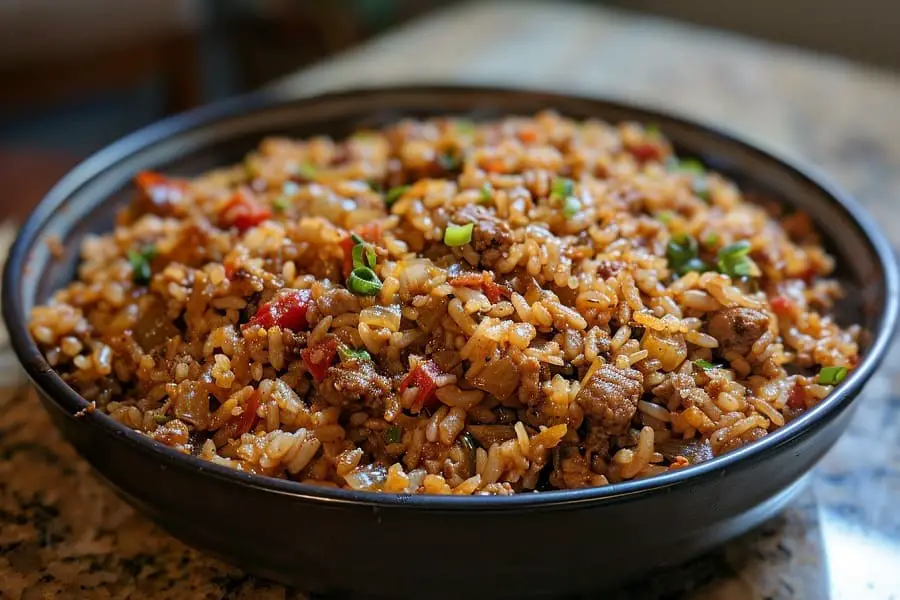Have you ever wondered why a dish named “dirty rice” holds a special place in Southern cuisine? Despite its unappealing name, this dish offers a flavorful, comforting experience deeply rooted in Louisiana’s culinary traditions. While the name might raise questions, understanding its origins will make you appreciate the rich history, culture, and recipes passed down through generations.
What is Dirty Rice?
This dish gets its “dirty” appearance from the way it’s prepared—white rice turns darker when cooked with finely chopped chicken livers, ground beef, and a mix of Cajun spices and vegetables. This transformation reflects the resourcefulness of cooks who turned simple ingredients into something special. Whether served as a side dish at a family gathering or enjoyed on its own, this recipe is more than just a meal—it’s a link to the past.
The Origins: A Rich History in Southern Cuisine
Dirty rice tells a story of resilience and creativity among African American cooks in Louisiana during the era of slavery. With limited resources, they used what was available, including chicken livers and gizzards, to create flavorful dishes. These ingredients, often seen as undesirable by their oppressors, became the foundation of a meal rich in cultural significance.
Historical Roots in Louisiana’s Cajun Cuisine
The dish is deeply rooted in Louisiana’s culinary traditions, influenced by African, French, and Spanish cultures. During slavery, plantation cooks often received basic, undesirable ingredients. White rice, a staple, lacked nutrition on its own, leading them to incorporate finely chopped meats and the “Holy Trinity” of Cajun cooking—onions, bell peppers, and celery—into the rice. This blend created the distinctive “dirty” appearance.
Necessity and Creativity: How It Became a Staple
Necessity drove the creation of this dish. Enslaved people showed resourcefulness by using every part of the animal to create meals that sustained them. Adding the “Holy Trinity” of Cajun cooking enhanced the depth and flavor, turning what others saw as waste into something nourishing and delicious. Over time, this dish symbolized survival and ingenuity, helping communities maintain a connection to their culinary heritage.
Why is dirty rice called dirty ?
The name “dirty rice” describes the dish’s distinctive look, resulting from the combination of ingredients that give the rice a “dirty” appearance. The process begins with browning meats like chicken livers, ground beef, or sausage in a hot skillet. As the meat cooks, it releases juices and oils that mingle with the rice, giving it a rich, brown color. This transformation from plain white rice to a more flavorful dish inspired the name.
Cultural Significance in Southern Cooking
This dish represents the resourcefulness and creativity of African American cooks in the Southern United States, particularly in Louisiana. Its cultural significance stems from the history of slavery, where cooks had to make the most of limited resources, turning less desirable parts of animals into a flavorful and hearty meal.
The Role in Southern Cuisine
In Southern cuisine, dirty rice exemplifies how humble ingredients can transform into something deeply satisfying. The dish’s origins trace back to Louisiana plantations, where scraps of meat, such as chicken livers and gizzards, were combined with rice and spices to create a filling, flavorful meal. This dish remains a staple in Southern kitchens today, appreciated for its rich history and deep flavor.
FAQs
1. What is dirty rice made of?
This dish typically includes white rice cooked with finely chopped chicken livers or gizzards, ground beef or sausage, and a mix of vegetables known as the “Holy Trinity” in Cajun cooking—onions, bell peppers, and celery. Seasoned with Cajun or Creole spices, it offers a deep, rich flavor and its characteristic appearance.
2. Why is it called dirty rice?
The name comes from the dish’s appearance. As the rice cooks with browned meats and vegetables, it takes on a dark, “dirty” color. This reflects the dish’s humble beginnings, where cooks used simple ingredients to create something flavorful and satisfying.
3. Is dirty rice the same as jambalaya?
While both dishes are popular in Southern cuisine, they differ in preparation. Dirty rice involves mixing cooked white rice with meat and vegetables, giving it a distinct look. Jambalaya, on the other hand, cooks the rice with the meat and vegetables from the start, allowing the rice to absorb the flavors and colors of the broth.
4. Can you make dirty rice without meat?
Yes, a vegetarian version can be made by substituting meat with mushrooms or other plant-based proteins. The key lies in maintaining the rich flavor profile by using the right combination of spices and vegetables.
5. What dishes go well with dirty rice?
This dish pairs well with various Southern favorites such as fried chicken, roasted duck, or even cornbread. It’s versatile enough to serve as a side or a main course.
Discover also :
Easy Cajun Dirty Rice Recipe with Chicken
Authentic Cajun Dirty Rice Recipe with Ground Beef
What is the difference between dirty rice and Cajun rice ?
Conclusion
This recipe offers more than just a meal; it symbolizes Southern culinary tradition and the resourcefulness of the African American cooks who first made it. From its origins as a way to make the most of available ingredients, this dish has evolved into a beloved staple of Southern cuisine. Whether served at home or in restaurants, its deep flavors and rich history continue to resonate.
Next time you’re in the mood for a dish that embodies the spirit of the South, consider making dirty rice. Perfect for family gatherings, potlucks, a hearty lunch, or whenever you want something flavorful. Don’t forget to experiment—whether adding sausage, making it vegetarian, or sticking to the classic recipe, this dish is versatile enough to suit any occasion.


3 thoughts on “Why Is Dirty Rice Called Dirty?”